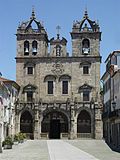Prior to 20th century
| History of Portugal |
|---|
 |
| Timeline |
- ca. 41 BCE - Installation of Roman milestones begins. [1]
- ca.16 BCE - Roman Bracara Augusta founded.
- 3rd C. CE - Town walls built. [2]
- ca.300 CE - Victor of Braga is martyred.
- 4th C. CE - Roman Catholic diocese of Braga established. [3]
- 5th C. CE - Suevi in power. [4]
- ca.450s - Roman Catholic Archdiocese of Braga established. [3]
- ca.485 - Visigoths in power. [4]
- 561-563 - Religious council meets in Braga. [5]
- 572 - Religious council meets in Braga. [5]
- 675 - Religious council meets in Braga. [5]
- 8th C. - Moors in power. [4]
- 1040 - Braga taken by forces of Ferdinand I. [4]
- 1089 - Braga Cathedral consecrated.
- 1093 - Braga becomes seat of royal court (until 1147). [4]
- 1417 - Fernando da Guerra becomes archbishop. [6]
- 1494 - Printing press in operation. [7]
- 1616 - Ponte do Prado (bridge) to Vila Verde rebuilt.
- 1642 - Construction of Igreja de Santa Cruz (church) begins. [8] [4]
- 1756 - Braga City Hall built. [9]
- 1841 - Biblioteca Pública de Braga (library) founded. [10] [11]
- 1857 - Public gas lighting installed. [12]
- 1858 - Population: 30,175. [13]
- 1875 - Ramal de Braga (railway) begins operating; Braga railway station opens. [12]
- 1880 - Rua D. Frei Caetano Brandão (street) developed. [12]
- 1882 - Bom Jesus do Monte Funicular begins operating.
- 1888 - Livraria Cruz (bookshop) in business.
- 1893 - Public electric lighting installed. [12]
- 1900 - Population: 24,202. [4]
